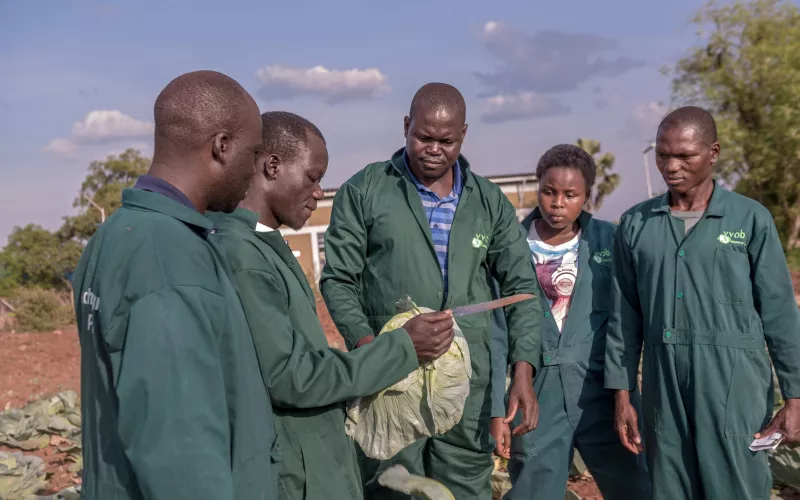
“The old curriculum made us the owners of knowledge. We lectured, and students followed. But now, with project-based learning, the students lead. We just facilitate.”
Embracing a New Way of Teaching
The shift from teacher-led instruction to student-driven learning has redefined education in her classroom. “The old curriculum made us the owners of knowledge,” Susan explains. “We lectured, and students followed. But now, with project-based learning, the students lead. We just facilitate.” Project-based learning, supported by the LEAP programme, is encouraging learners to identify real-world challenges, conduct research, develop solutions and skills.
One of Susan’s proudest moments came through a student named Lukwiya, who was inspired by the vegetable-growing project they started at school. Lukwiya then began growing vegetables at home. “This boy has gone an extra mile,” Susan shares. “Nowadays, he sells these vegetables and he’s paying his school fees using that money.”
How Project-based Learning Comes to Life in the Classroom
Susan narrated how project-based learning unfolds in her classroom. It begins with identifying a real-world challenge from the community and crafting a driving question that aligns with the curriculum. This initial stage sets the tone for inquiry and relevance. From there, students dive into research, gathering insights from their surroundings, peers, and even local experts. Susan often invites successful farmers or entrepreneurs to share their experiences, helping learners connect theory with practice.
Once students have built a solid foundation of knowledge, they move into hands-on activities where they apply what they’ve learned. This phase is rich with experimentation, teamwork, and peer-to-peer critique. Susan encourages students to work in diverse groups, rotate roles, and ensure that everyone, including quieter learners and girls, has a voice. As projects take shape, learners refine their work through feedback and reflection, often revisiting earlier steps to improve outcomes.
Finally, students present their projects, showcasing not just the final product but the journey of learning behind it. Whether it’s a thriving vegetable garden or a poultry unit, these presentations allow learners to celebrate their achievements and demonstrate the skills they’ve gained. For Susan, this process ensures that knowledge is not only acquired but deeply embedded and ready to be used in life beyond the classroom.
Challenges and Creative Solutions
Implementing project-based learning hasn’t been without its challenges. “Our timetable doesn’t favour PjBL,” Susan admits. “Eighty minutes isn’t enough when you’ve invited a community expert.” She’s also faced issues with school resources and student motivation. “Sometimes the school wants to take the vegetables for free, yet the students are developing their entrepreneurial skills,” she says. To overcome these challenges, Susan has adapted. “I’ve adjusted to use only what we can get locally. Things which need much money for buying, I have excluded. We are going to start with what we can get locally, like materials for construction, and we are going to use grass for thatching.”
A New Culture of Learning
Susan describes the transformation in her students as remarkable. “Teaching has become sweet,” she smiles. “You see the effect in the child immediately. They grasp the knowledge and apply it.” Students now come to class prepared, eager to collaborate and solve problems. “If you have given them a driving question, they are working in groups. Even before class time, you will see everybody preparing.”
The skills they acquire include critical thinking, teamwork and leadership. They extend beyond the classroom and into their homes and communities. “The knowledge they gain, they take it back home,” Susan says. “It has also encouraged the learners to involve themselves in activities that can even help them to earn income.”
A Call to Action for Teachers and Leaders
Susan implored her peers to embrace the change. “My fellow teachers should know that teaching has changed. Everything has changed, actually, not only teaching. Life, lifestyle and other things have changed. So the teachers must also accept this change and move with it.”
She also calls on school leaders to support teachers by organising mini workshops and sharing resources. “If Susan has been trained and there are others in the department, the school can organise a mini workshop so that Susan trains the rest.”
Community Transformation One Classroom at a Time
Susan Akot’s story is a powerful example of how project-based learning is transforming her community in Gulu District. By making education relevant, practical, and empowering, she is not only transforming her classroom but also her community.
Her students are becoming problem-solvers, entrepreneurs, and active citizens, ready to face the future with confidence. And with teachers like Susan leading the way, the future of education in Uganda is bright.